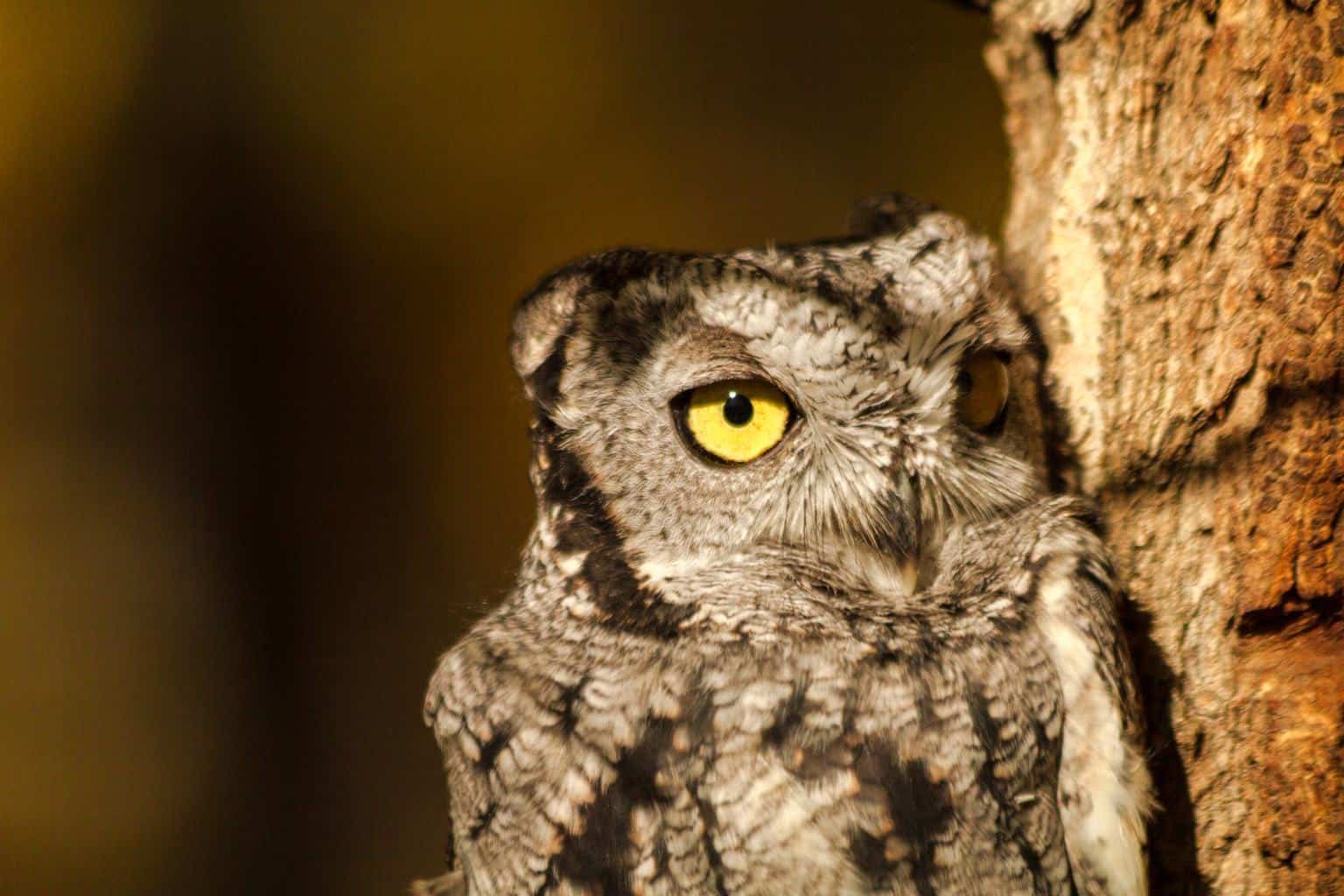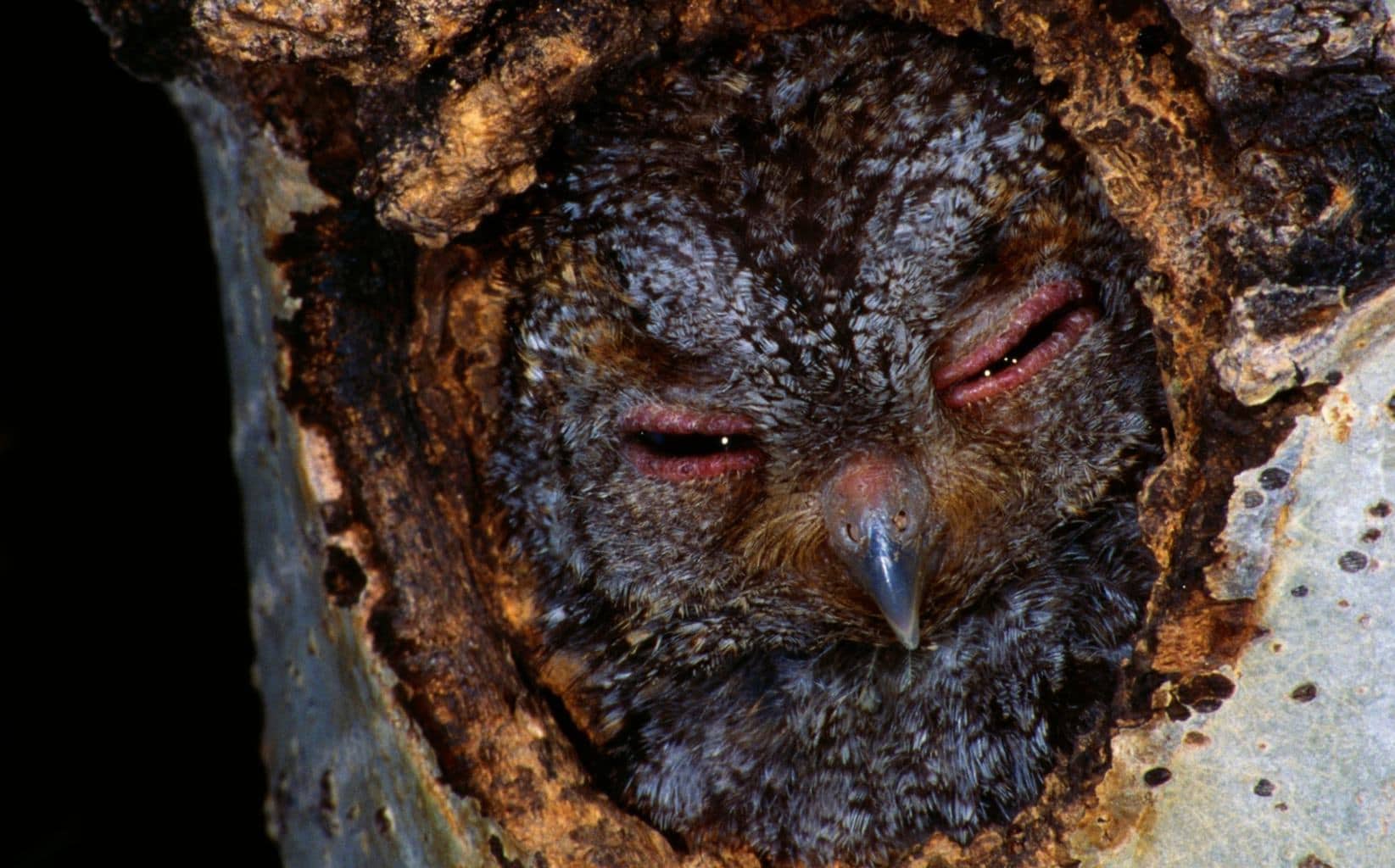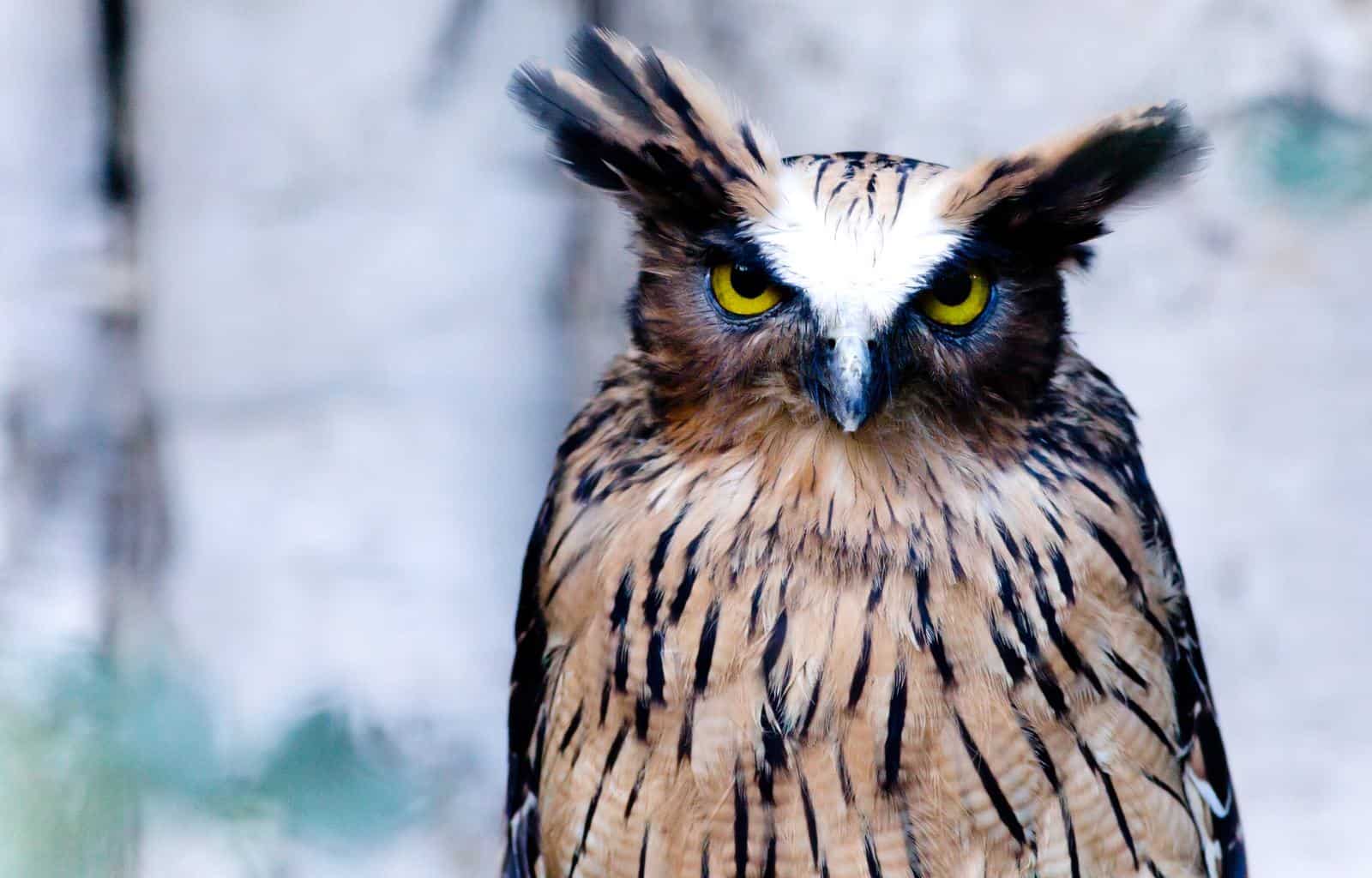Of the 19 species of owls found in the United States, 14 of them can be found in Idaho! It’s one of the best states for looking for a variety of birds, including owls and watching them in their habitats, and since the Gem State has nearly 4,532,000 acres of wild land and forests, it’s no wonder our feathered friends think it’s an excellent place to live and breed.
There are seven national forests in the state, covering nearly 20.4 million acres, which translates to about 40 percent of the land. A total of 432 bird species live there, including the owls we’ll talk about below.
Ready to find out about these birds’ behavior and unique characteristics? Read on!
Great Gray Owl

- Scientific Name: Strix nebulosa
- Length: 25-33 inches
- Weight: 1.5-4 pounds
- Wingspan: 60 inches
The great gray owl is the largest species of owls found in the United States, and it’s a larger bird than most other species of owls found outside of North America; in fact, it’s the third-largest owl in the world. Needless to say, you’ll have to be careful around this bird!
These owls have the largest facial disk any bird can have, and their gray and black feathers are positioned around the ear so they can direct sounds toward it. That’s why these owls have impeccable hearing, and they are avid hunters.
In Idaho, great gray owls are mostly found in open forests, and you’ll likely find them near empty clearings.
Barred Owl

- Scientific Name: Strix varia
- Length: 16-25 inches
- Weight: 1-2.75 pounds
- Wingspan: 38-49 inches
The barred owl is classified as one of the world’s scariest birds, partially because of its jet-black eyes. It may also be because barred owls are excellent camouflagers, thanks to their mottled feathers.
Barred owls are the most common species in Idaho, so you’ll run across a lot of them in the wild. They’re known to keep observing anyone getting close to them, so don’t get creeped out if they do that.
Their calls are common sounds, too. They sound as if the bird is asking, “Who cooks for you?” and this species’ caws are usually used when you hear the classic sounds of an owl on a movie or television show.
Barn Owl

- Scientific Name: Tyto furcata
- Length: 13-15 inches
- Weight: 1-1.3 pounds
- Wingspan: 42-43.3 inches
Barn owls are the most common species in the United States, and they’re one of the most common in the world. They’re known for their heart-shaped white faces that make them look like ghosts in the night.
These owls are spread throughout Idaho, but they’re more common near the southwest and rare in the north. You may run across them near the Snake River Canyons, though.
Western Screech-Owl

- Scientific Name: Megascops kennicottii
- Length: 7.5-10 inches
- Weight: 3.5-11 ounces
- Wingspan: 22-24 inches
Western screech-owls look a lot like their eastern counterparts, so much so that they were considered one species at some point.
These owls prefer staying in high-altitude forests, but they’re also found in abundance in deserts, suburban parklands, and farm fields. Your best chance at finding them, however, is at night, since they’re nocturnal hunters who search for food when darkness falls.
Western screech-owls’ numbers are declining in the Gem State due to habitat loss, but don’t worry; their numbers are still high enough for you to catch a glimpse of them.
Short-Eared Owl

- Scientific Name: Asio flammeus
- Length: 13-17 inches
- Weight: 7.3-16.8 ounces
- Wingspan: 33.5-40.5 inches
Short-eared owls’ Latin name, flammeus, was given to the birds because their feathers look like erupting flames. These medium-sized birds are unique, and their short ear tufts add to their overall adorable look. When they want to look scary, though, those tufts erect.
In Idaho, these owls are classified in need of great conservation, mainly due to habitat loss. However, they’re present in large numbers in the southern regions, Camas Prairie, and the Palouse.
Its favorite foods are mostly rodents, but they’ll also eat shrews, gophers, bats, or muskrats.
Long-Eared Owl

- Scientific Name: Asio otus
- Length: 13.8-15.8 inches
- Weight: 7.8-15.5 ounces
- Wingspan: 35.5-39.5 inches
Long-eared owls are among the easiest to identify because of the large tufts of feathers on their heads that look like ears. They also have large round yellow eyes and large facial disks with orange-colored feathers.
These owls are spread throughout Idaho, but they’re more common in the southern regions. You’ll likely find them in low-elevation areas with nesting habitats.
Flammulated Owl

- Scientific Name: Psiloscops flammeolus
- Length: 5-6 inches
- Weight: 1.8-2.3 ounces
- Wingspan: 14 inches
The most distinct feature of flammulated owls is their jet-black eyes. If you make eye contact, you’ll feel just like you’re looking into the night! The circle of dark feathers rimming their eyes doesn’t help that feeling, either.
These owls are small-sized, and they have impressive camouflage skills, so you may have to work to catch them. They’re found in large numbers around the south of Salmon River, but they only spend the breeding season there.
Just like short-eared owls, flammulated owls are suffering from habitat loss.
Boreal Owl

- Scientific Name: Aegolius funereus
- Length: 9.5-11.5 inches
- Weight: 3.5-7 ounces
- Wingspan: 22-24 inches
Boreal owls are on a swinging scale between small and medium sizes. They’re smaller than most species of owls, but they’re bigger than the ones classified as small, like flammulated and elf owls.
These champions sport chocolate brown feathers with white spots all over. Their faces have black edges, making them look like they have square facial disks. Additionally, their eyes are yellow and wide.
In Idaho, these owls are present in many counties, including Fremont and Lemhi, and they also live in remote forested areas.
Great Horned Owl

- Scientific Name: Bubo virginianus
- Length: 17-25 inches
- Weight: 2.5-4 pounds
- Wingspan: 36-60 inches
You may already be familiar with great horned owls because of Owl, the beloved Winnie the Pooh character. However, these owls aren’t as friendly as the fictional ones. In fact, they’ve been classified as the world’s scariest birds, and they’re the most aggressive species in the United States.
These owls have large tufts of feathers on their heads that look like horns. They’re nocturnal, so your best chance of seeing them is at night. You won’t have trouble finding them in Idaho, though, as they’re spread throughout the state.
Great horned owls mostly nest in open woodlands, swamps, and canyons, and they stay away from high elevation areas. They have a rather poor sense of smell, which is why you might find these woodland birds eating smelly skunks from time to time!
Burrowing Owl

- Scientific Name: Athene cunicularia
- Length: 8-11 inches
- Weight: 5.5-8.5 ounces
- Wingspan: 21-24 inches
Burrowing owls are birds of prey with pretty faces. Their eyes are narrow, giving a feeling that tall eyelashes surround them. On top of that, they have long legs that help them stand in a straight stance.
This species of owls are very vocal; you’ll likely hear their sounds before you see them. They’re known to live in abandoned burrows in the ground, and they prefer staying near deserts and forests. You’ll only see them in the southern regions in Idaho, particularly near the southwest.
Snowy Owl

- Scientific Name: Bubo scandiacus
- Length: 20.7-25 inches
- Weight: 3.3-4 pounds
- Wingspan: 47-60 inches
Snowy owls have pretty faces, but they’re as vicious as owls come. They join the great horned and great grey species as the scariest owls, and these champions feed on prey birds of every kind, arctic wolves, and sometimes even humans!
Their large size helps them with their hunting endeavors, as their wings alone can reach up to five feet.
Snowy owls aren’t common in the United States, but you may see them in Idaho in open areas, such as prairies, meadows, and marshes. Most of their sightings have been in the northern areas during the winter season.
Northern Saw-Whet Owl

- Scientific Name: Aegolius acadicus
- Length: 7-8.3 inches
- Weight: 2.3-5.5 ounces
- Wingspan: 16.5-19 inches
The northern saw-whet owl is a small bird, but its broad wings that flatten out during flight tricks birdwatchers into thinking it’s larger. This species of birds looks strikingly similar to boreal owls, but they don’t have the signature black feathers around the edges of their faces.
They spend the whole year in Idaho, but some of them migrate to lower elevation areas in the winter. They also prefer living in heavily forested areas.
Northern Pygmy-Owl

- Scientific Name: Glaucidium californicum
- Length: 6-7 inches
- Weight: 2.2-2.5 ounces
- Wingspan: 15 inches
Northern pygmy-owls are the second smallest owls on our list, coming second only to flammulated owls. Despite their size, however, these owls are known for being aggressive and bold. They mostly nest in tree cavities that were dug by woodpeckers.
Northern pygmy-owls have feather patterns on the backs of their necks that look like eyes. Although odd, these patterns protect them from back threats.
In Idaho, you can find northern pygmies in forests near clearings, like swamps and meadows.
Northern Hawk Owl

- Scientific Name: Surnia ulula
- Length: 14.3-17.8 inches
- Weight: 12 ounces
- Wingspan: 30-35 inches
Northern hawk owls look pretty much like hawks. If you don’t look closely, you’ll mistake it for the infamous bird of prey. However, that similarity in physical appearance isn’t the reason for the species’ name. Northern hawk owls were given that name because they act just like hawks, even boasting similar cries.
Northern hawk owls originally hail from Canada, only venturing into the United States when they can’t find prey. They’re uncommon residents of Idaho, but you may run across these feathered friends in forests near streams and swamps.
Final Thoughts
We hope you’ve enjoyed our list of birds of prey, specifically owls, in the Gem State! Thanks to Idaho’s fair share of owl species, it’s no wonder the state is a favorite among avid birdwatchers. If you’re staying there, you’ll see a wide variety of owls and may see some rare species if you’re lucky.
If you don’t want to miss other interesting birds in Idaho, check out our list of the state’s hawks!

